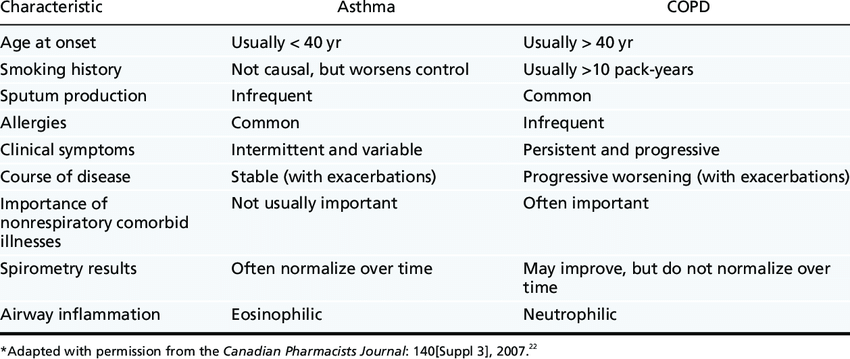Blog Details

As a patient with lung condition or as a caregiver for a lung disease patient, it can be overwhelming to get a grasp of various names and their symptoms. We bring you this detailed post that talks about the differences between Asthma and COPD. Let us deep dive and understand both the conditions and their differences.
Asthma is defined as a chronic inflammatory disorder of the airways, in which the chronic inflammation induces hyper-responsiveness of the airway that leads to recurrent episodes of wheezing, breathlessness, chest tightness and coughing, specifically at night or in the early morning. These episodes are caused due to variable obstruction in airflow, and can be resolved, either spontaneously or with treatment. Approximately, 300 million people worldwide suffer from asthma.
Asthma can occur due to a number of reasons. While some might be genetically pre-disposed to allergy and airway hyper-responsiveness, asthma may also arise from factors such as obesity and sex. Further, environmental factors may include allergens, occupational sensitizers, lung infectious, tobacco smoke, outdoor/indoor air pollution, and diet. Thus, asthma is not solely induced by inhalation of noxious gases and fumes alone.
COPD is a chronic pulmonary disease with persistent airway obstruction. COPD is characterized by reduced airflow that is not fully reversible. The airflow limitation is usually progressive, and worsens over time, and is associated with an abnormal inflammatory response of the lungs to noxious particles or gases. In COPD, the air sacs in the lungs lose their elasticity and thus limiting the ability of the lungs to absorb oxygen adequately.
COPD is the 3rd leading cause of death in the world and is usually common among cigarette smokers, and individuals exposed to fumes emitted by burning biomass for cooking and heating in poorly ventilated homes. As per a study conducted in 2017, COPD was found to be the 2nd leading cause of death after heart disease.
Both asthma and COPD can have overlapping symptoms and it is difficult to identify asthma from COPD purely on the basis of symptoms.

Symptoms of Asthma
The symptoms include the following:
Symptoms of COPD
The symptoms include the following:
As mentioned before, there also exist systemic manifestations and co-morbidities in COPD, which include:
Occurrence of the aforementioned along with elementary COPD symptoms might be taken into account by a physician to make a diagnosis.
In both asthma and COPD, adequate and regular treatment will reduce symptoms, flare-ups, and improve the overall quality of life of the patient.
Treatment of asthma
Treatment of asthma involves the suppression of airway inflammation, with the end goal of regaining total control of the respiratory symptoms. ICS (inhaled corticosteroids), along with bronchodilators the most important medications used in asthma patients help prevent exacerbations, improves pulmonary function, slows down disease progression, decreases airway re-modelling, and reduces the need for additional medications.
Treatment of COPD
Treatment of COPD involves relieving breathlessness, the most bothersome symptom in COPD patients. Additionally, COPD treatment is also aimed towards preventing exacerbations, and decreasing mortality. Long-acting bronchodilators forms the central pillar in treating COPD patients. In COPD, ICS are only useful in patients with repeated exacerbations, history of asthma and advanced COPD.
In both asthma and COPD, early diagnosis & treatment can influence morbidity and mortality. The quality of life would become improved, and the cost of treatment would be reduced.
According to the course of illness, individuals must be strongly discouraged from smoking. This is because there is no therapy that can remodulate the airway in either asthma or COPD.
While making a diagnosis for asthma and COPD, doctors tend to look at essentially the following criterions:

Your general physician may be best equipped to make a diagnosis for COPD or asthma based on imaging, medical history, and symptoms. Both asthma and COPD are chronic conditions which cannot not be cured. However, both can be managed by effective treatment and lifestyle changes, such as avoiding exposure to air pollution, smoke, and other irritants.
© 2026 Healthy Lungs.